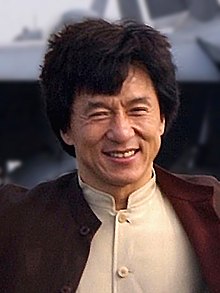
Jackie Chan was born in Hong Kong on April 7th, 1954. His parents, Charles and Lee-lee Chan named him Chan Kong-sang which means "born in Hong Kong." Jackie weighed 12 pounds when he was born and his mother required surgery to deliver him. Jackie's parents were so poor that they had to borrow money from friends to pay the doctor.
When Jackie was seven years old Charles took a job as the head cook at the American embassy in Australia. He felt that it would be best for Jackie to stay behind in Hong Kong to learn a skill and so enrolled him in the China Drama Academy where Jackie would live for the next 10 years of his life.
During Jackie's time at the school, he learned martial arts, acrobatics, singing, and acting. The school was meant to prepare boys for a life in the Peking Opera. Chinese opera was very different from any other kind of opera. It included singing, tumbling, and acrobatics as well as martial arts skills and acting.
While at the China Academy, Jackie made his acting debut at age eight in the Cantonese movie "Seven Little Valiant Fighters: Big and Little Wong Tin Bar." He later teamed with other opera students in a performance group called "The Seven Little Fortunes." Fellow actors Sammo Hung and Yuen Biao were also members. Years later the three would work together and become known as The Three Brothers. As Jackie got older he worked as a stuntman and an extra in the Hong Kong film industry.
When Jackie was 17, he graduated from the China Drama Academy. Unfortunately the Chinese opera was no longer very popular, so Jackie and his classmates had to find other work. Each year many movies were made in Hong Kong and there was always a need for young, strong stuntmen. Jackie was extraordinarily athletic and inventive, and soon gained a reputation for being fearless; Jackie Chan would try anything. Soon he was in demand.
Over the next few years, Jackie worked as a stuntman, but when the Hong Kong movie industry began to fail, he was forced to go to Australia to live with his parents.
Jackie was very unhappy in Australia. The construction work was difficult and boring. His salvation came in the form of a telegram from a man named Willie Chan. Willie Chan worked in the Hong Kong movie industry and was looking for someone to star in a new movie being made by Lo Wei, a famous Hong Kong producer/director. Willie had seen Jackie at work as a stuntman and had been impressed. Jackie called Willie and they talked. Jackie didn't know it but Willie would end up becoming his best friend and manager. Soon Jackie was on his way back to Hong Kong to star in "New Fist of Fury." It was 1976 and Jackie Chan was 21 years old.
Jackie was becoming a huge success in Asia. Unfortunately, it would be many years before the same could be said of his popularity in America. After a series of lukewarm receptions in the U.S., mostly due to miscasting, Jackie left the States and focused his attention on making movies in Hong Kong. It would be 10 years before he returned to make Rumble in the Bronx, the movie that introduced Jackie to American audiences and secured him a place in their hearts (and their box office). Rumble was followed by the Rush Hour and Shanghai Noon series which put Jackie on the Hollywood A List.
Despite his Hollywood successes, Jackie became frustrated by the lack of varied roles for Asian actors and his own inability to control certain aspects of the filming in America. He continued to try, however, making The Tuxedo, The Medallion, and Around the World in 80 Days, none of which was the blockbuster that Rush Hour or Shanghai Noon had been.
Jackie's lifelong devotion to fitness has served him well as he continues to do stunt work and action sequences in his films.
Jackie has been married to Lin Feng-Jiao since 1982 and has a son, actor-singer Jaycee Chan. To learn more about Jackie you can read his biography, I Am Jackie Chan.





